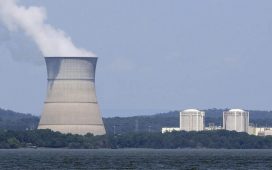A major earthquake in Southern California this week has reignited fears that the ‘Big One’ is coming, but scientists say it may come from an unlikely source.
The little-known Elsinore fault is branch of the infamous San Andreas fault, stretching over 100 miles across Southern California, from the US-Mexico border, through San Diego and Riverside Counties, and up towards Los Angeles.
The California Institute of Technology has noted that the Elsinore fault, which sits just 15 miles from San Diego County, is one of the largest fault zones in Southern California.
While it’s been one of the quietest throughout recorded history, seismologist Lucy Jones warned that Elsinore is still capable of producing an earthquake up to 7.8 in magnitude.
The last time the Elsinore fault produced a major earthquake above 6.0 in magnitude was in 1910, but data from the US US Geological Survey (USGS) and Southern California Earthquake Center shows that such events occur every 100 to 200 years.
‘The Elsinore fault is one of the major risks in Southern California,’ Jones said after the 5.2 magnitude quake in San Diego on Monday.
‘The last couple years, we’ve been having more felt-earthquakes than we had for several decades,’ she added.
With seismic activity seeming to be on the rise, USGS has created their own predictions of what a catastrophic earthquake could look like if the ‘Big One’ struck the Elsinore fault instead of the San Andreas.

The US Geological Survey simulated what a 7.8 magnitude earthquake along the Elsinore fault would look like – with devastating results
That massive event would likely spread destruction from San Diego to Los Angeles and possibly far beyond.
The Elsinore fault is a separate fault line but still part of the larger San Andreas fault system, a group of faults that work together to handle the movement of tectonic plates in California.
Elsinore runs parallel to and east of the San Andreas in Southern California. It extends from the US-Mexico border through San Diego County and is about 110 to 150 miles long.
Dr Jones confirmed that Monday’s seismic event was associated with seismic activity in the Elsinore fault line.
‘The Elsinore is sort of a junior sister to the San Andreas. This San Andreas breaks up when it comes into Southern California and splits into four parallel faults – the San Andreas, the San Jacinto, the Elsinore, and the Newport-Inglewood,’ Jones explained to KCAL News.
Although earthquakes happen less often along the Elsinore, the seismologist warned that, when one does strike, the damage can spread all the way to Los Angeles – home to nearly four million people.
In 2017, USGS ran a simulation of a 7.8 magnitude earthquake along the Elsinore fault, running northwest into the connecting Whittier fault line – which is closer to Los Angeles.
In Los Angeles, that version of the ‘Big One’ would have brought violent shaking and widespread structural damage to buildings and their foundations.

A seismologist has warned that earthquake activity in California is picking back up to levels that haven’t been seen since the 1980s
Charting the destruction on a scale of seismic activity called Modified Mercalli Intensity (MMI), USGS researchers predicted that the MMI in Los Angeles would reach level 7.5 to 9.0 – near the top of the scale.
Only levels 10 through 12 are more extreme, and that much seismic activity would bring ‘total destruction.’
In San Diego, the hypothetical earthquake would bring an MMI between 4.0 and 6.5, causing strong shaking, cracked walls, collapsed chimneys, and some damage to other structures throughout the city.
Overall, the prediction found that the damage to San Diego would be manageable, with a low risk of widespread injuries.
However, if a massive 7.8 magnitude quake spread from the Elsinore fault to the connecting Whittier fault, Los Angeles would see a high likelihood of injuries, fatalities, and substantial economic losses.
Cities as far east as Las Vegas (300 miles from LA) would feel moderate shaking that could still cause minor damage – reaching an MMI of 4.5.
The seismic force would also spread north, reaching cities like Santa Barbara, Bakersfield, and Fresno. That’s an area encompassing more that 23 million people.
Jones noted that two major Earthquakes in the 1990s – the magnitude 7.3 Landers earthquake in 1992 and the magnitude 6.7 Northridge earthquake in 1994 – ‘depressed’ the local tectonic stress in South California for decades.
This kept things relatively quiet for years, Jones said, but it now appears that the region is starting to experience the same increased seismic activity it did in the 1980s.
Previous estimates of an earthquake approaching 8.0 on the Richter scale along the San Andreas fault projected that there could be 1,800 deaths and 50,000 injuries across California.
The San Andreas fault runs through major cities like San Francisco, San Bernardino, and Palmdale, as well as near Los Angeles and Palm Springs.
The over-800-mile-long fault was responsible for the devastating 1906 San Francisco earthquake, which is believed to have reached magnitude 7.9.
That quake left 80 percent of the city destroyed and more than 3,000 people dead.











